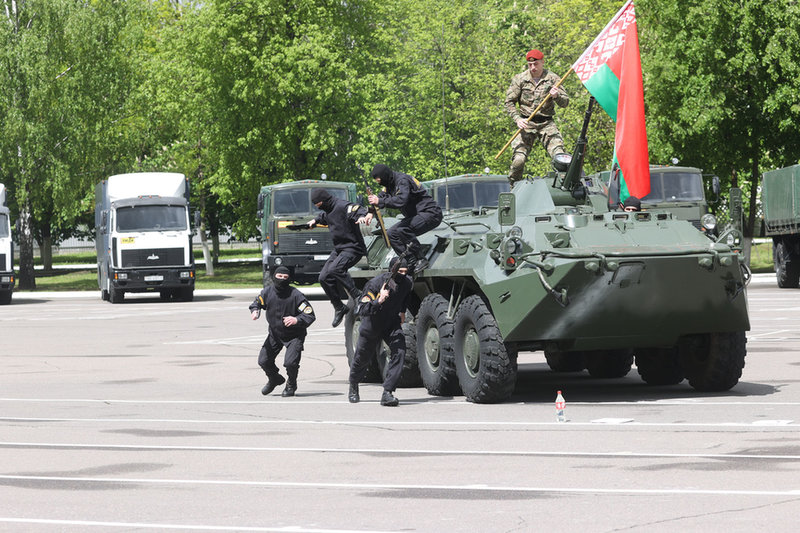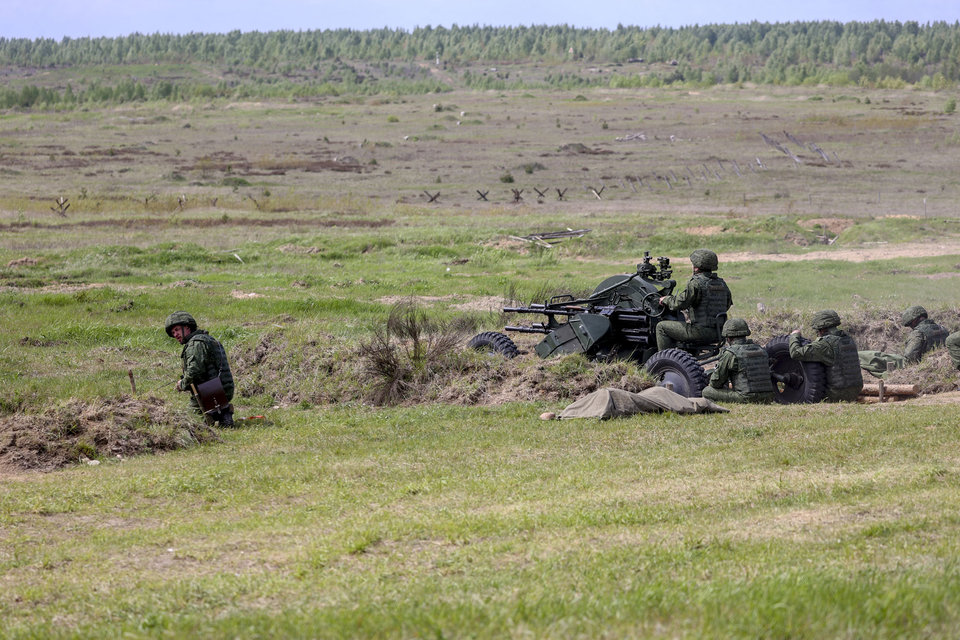COUNTRY ANALYSIS
Ukraine-Russia war: what will Belarus do?
Belarus’s military capabilities do not align with the conventional war being fought by Russia in Ukraine, should Minsk be brought into the conflict. Samuel Cranny-Evans reports.
India has commissioned into service the INS Vikrant, its first indigenously manufactured aircraft carrier. Richard Thomas details the platform’s capabilities.
Belarus had not existed as a definable state until 1917 following the Russian revolution, with the territory that now forms Belarus had been fought over by Kievan Rus, Lithuania, Poland, and Russia at various times throughout history.
Part of what was then a Soviet Republic were lost in the 1919 war with Poland, only to be returned in 1939 after the Soviet invasion of Poland. The borders were consequently finalised after WW2, however, its turbulent past meant that there was not a strong vein of Belarussian nationalism when the Soviet Union collapsed in 1991.
By the end of the Cold War, Belarus was expected to host and become the launch pad for second echelon forces during a war with NATO. Because of this it was the base for around 180,000 Soviet troops in 1991, although only half of them answered to what was the Belarussian Military District, the other half were subordinated directly to the Soviet General Staff in Moscow.

// Personnel from the 3rd Special Purpose Brigade demonstrate capabilities during a showcase event Minsk in May this year. Credit: Stringer/Anadolu Agency via Getty Images
The new government of Belarus abolished the Belarussian Military District in 1992 assigning half of the 180,000 troops to its Ministry of Defence, according to a 1993 article written by Frank Umbach of the German Federal Institute for Eastern Studies. Withdrawals from Warsaw Pact countries further increased the troop concentration in Belarus to 250,000 - one serviceman for every 43 citizens.
Belarus adopted a strategy of mobile defence with wary eyes on its neighbours: Russia, Ukraine, and Poland. Belarus could not support its armed forces independently and relied on support from Russia, it also agreed to maintain Russian air and military bases on its territory and began a process of focusing its units around mobile mechanised brigades. It was originally planned for Russian troops to withdraw, but Lukashenko’s erratic policies led to them remaining to ensure his presidency.
Interestingly, Umbach wrote that from Poland’s perspective, Belarus was either the forward edge of Russia’s defences, or a springboard for military action. One could argue therefore, that the country’s role in the war against Ukraine was predicted nearly 30 years ago. However, attention has turned recently to the Belarusian armed forces themselves, and any potential role that they might play in Ukraine. The forces are shaped extensively by their Soviet heritage and are likely subject to similar pressures as those found in the Russian Armed Forces as a result.
Belarussian ground force focus
The bulk of the Belarussian armed forces are concentrated in its Ground Forces. Figures vary wildly, but the International Institute of Strategic Studies estimated there to be 48,000 in 2017. Since 1995 a series of reforms have attempted to shift the ground forces to a more professional footing with 40% of their personnel serving under contracts, as opposed to the Soviet conscription model. It is not clear how many of Belarus’s troops are contract personnel, but its Ministry of Defence has indicated that it takes in about 10,000 conscripts per year.
The Ground Forces operate a mix of equipment including modernised BTR-70MB1s, T-72As, T-72B3s, and MZKT series armoured 4x4s. It has also received a small quantity of BTR-82s armed with the 2A72 30mm cannon that are sufficient for at least one battalion’s worth of equipment.
However, if Belarus were to contribute more than its airspace to Russia’s war in Ukraine, its ground forces might not be the most obvious choice. As is the case in Russia, the most combat capable and available units are probably focused on the country’s ‘special operations forces’, which may number around 5,000 personnel. They are required to perform a number of roles and have conducted joint training with Russian special forces in the past, however, there is a focus within the Belarussian armed forces on internal security that has been present for some time.
As such, the force has gained a reputation for brutal suppression of dissent and provide counter-terror, air defence, and electronic warfare expertise that has been exported to Venezuela, Yemen, and Libya. Nigerian special forces have also been observed training in counter-terror operations in Belarus.
This suggests that Belarussian military expertise, such as it is, resides in specialist skills and may not be most usefully employed in the conventional military operations that are prevalent in Ukraine.
However, Belarus retains a considerable arsenal of armoured vehicles and logistics platforms. The country was permitted to retain 1,800 tanks and 2,000 armoured fighting vehicles under the Conventional Forces Europe treaty, and some estimates indicate that at least 1,000 remain in Belarus, with as many as 500 in service.
Current reporting also suggests that 94 T-72A tanks may have been transferred to Russian forces, along with 44 trucks. It stands to reason that supplying Russian troops could be one of the more productive ways in which Belarus will support Russia’s war effort.
Air attack and air defence
Belarus maintains a relatively well-equipped air defence force equipped with 11 S-300PS strategic air defence systems supported by 9K37 Buk and Tor-M2E short range air defence systems. The S-300s are designed to be integrated into Russia’s strategic air defence network and contribute to a common air picture; although it is not clear that they are able to operate independently in a national-only context.
They are supported by a small fleet of fixed wing MiG-29S air superiority fighters and Su-25 ground attack aircraft. The ground-based air defence would be unlikely to offer anything beneficial to Russia within the current geographical constraints of the war, but the aircraft could conceivably be more useful in exerting effects on Ukraine.

// Belarussian forces are seen conducting an annual training exercise dubbed ‘Military Security and Defence of the State’, outside of Minsk in May this year. Credit: Stringer/Anadolu Agency via Getty Images
One final element to consider is Belarus’s long-range precision strike systems such as the 301mm Polonez multiple rocket launcher, which was developed with assistance from China, and has a range of 200km with a circular error probably of 50m at maximum range. An improved version of the missile is claimed to be capable of striking targets at 300km, the manufacturer’s promotional video indicates it is designed to engage critical national infrastructure such as power stations.
The Polonez can fire eight A200 missiles in 50 seconds, each carrying a warhead weighing 140kg. It is understood that 10-12 launchers equip the country’s 336th Rocket Artillery Brigade, and are used by the 77th Independent Rocket Artillery Battalion.
From the border of Belarus, the Polonez would be well within reach of Kyiv and offer President Aleksandr Lukashenko a relatively low risk route to support Russia’s war. Alternatively, the systems and missiles could be provided to Russian forces to enhance their precision strike arsenals. This is perhaps one of the more likely routes given Russia’s efforts to acquire munitions from Iran and North Korea.
The Polonez manufacturer also claims to produce 122mm guided rockets for the BM-21, which would be potentially valuable for the Russian forces.
What role for Belarus in Russia’s war?
The potential role of Belarus in Russia’s war with Ukraine is difficult to predict because Lukashenko has always maintained a cautious balance of relations with Russia and the West, although his position has shifted significantly in favour of Moscow since the rigged elections in 2020 subsequent protests.
However, it is worth noting that Belarus was found to be supplying Chechen fighters with equipment against the Russian forces in 2001. Reports also emerged of the Almaz anti-terrorist squad, which was used to ‘liquidate’ Lukashenko’s opposition, but also made its way to Chechnya to fight on the side of the Chechen militants. Lukashenko has also, at times, resisted closer military ties with Russia. As a result, the country’s policy towards Russia is not binary and it does not follow that Lukashenko is willing to commit his forces and the future of his regime to the war in Ukraine.
// Main image: A Belarus T-72 B3 tank with Belarussian flag attend the finals of the tank biathlon on 27 August, 2022, in Alabino, outside of Moscow, Russia. The International Army Games ARMi-2022, organised by Russian Ministry of Defence, ran from 13-27 August against the tense backdrop of war in Ukraine. Credit: Contributor/Getty Images
Northrop’s Integrated Air and Missile Defence Battle Command System connects sensors and effectors that were not designed to work together into a single network.